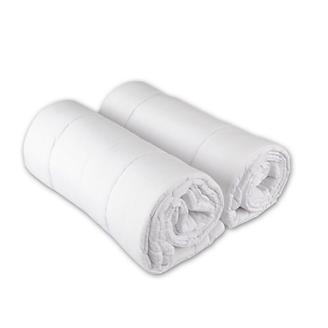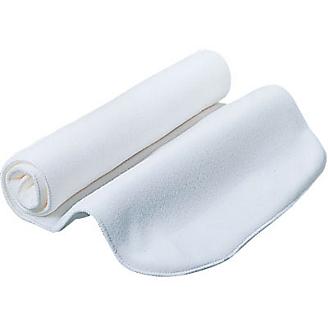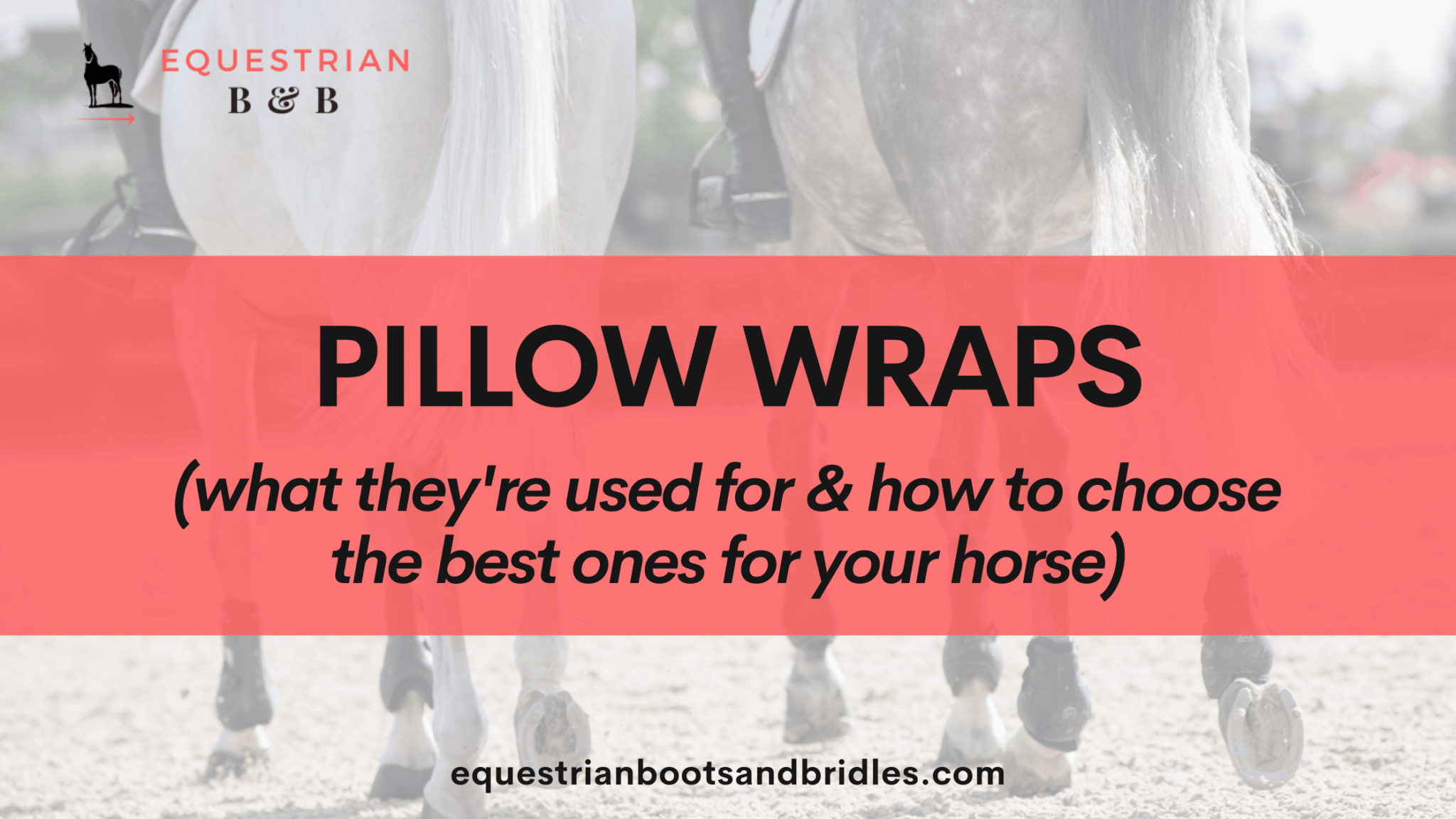A long time ago, when I first saw pillow wraps, my instinct was to ask what injury the horse had sustained. The owner of that horse giggled and asked me if I had never heard of pillow wraps for horses before. Eager to learn, I popped around to my local vet to find out more.
Here’s all you need to know about pillow wraps for horses (also known as leg wraps): what they are, how to fit them, and how to choose the best type for your horse’s legs.
What Are Pillow Wraps?
Pillow wraps are large padded squares that are applied to the horse’s legs below the knee and up to the horse’s fetlock joint. Elasticated bandages or standing wraps for horses are used to secure the pillow wraps to the horse’s legs.
While you can definitely use pillow wraps to treat an existing injury, you can also use them to prevent an injury from happening when trailering your horse or when they are in a stable and are prone to swollen legs. The gentle pressure of the pillow wraps is ideal for preventing swelling and improving circulation post exercise.
With a pillow wrap, you can stimulate blood flow, improving circulation. These wraps should be part of any first aid kit for horses and can be used to administer a poultice to the horse’s legs to reduce inflammation or prevent swelling. Pillow wraps should be part of the basic horse care essentials in your grooming box.

How to Choose Pillow Wraps for Your Horse’s Legs
When considering the different pillow wraps on the market (and there are quite a few brands!), you should keep the following in mind:
1. Potential Use
What you want to use the wraps for will determine the kind of wraps you choose. You may use them for preventative reasons, to aid in recovery, for travel, and/or for other types of protection.
If you have a horse that’s prone to injuries, then a set of magnetic pillow wraps may be a great investment. If you do a lot of jumping or strenuous riding, then recovery wraps or medicinal wraps might be beneficial for your horse.
Stable bandages are ideal for horses who are kept in close confinement. The bandages on the horse’s lower leg will help prevent swelling. Add some pillow wraps and you have excellent alternatives to shipping boots, stall bandages, and bow wraps.
Keep in mind you will have to purchase standing wraps or polo wraps that can secure the pillow pads in place. In my experience, these standing bandages are the best standing wraps for horses as they are easy to fit, wrap neatly, retain some resistance, and don’t show dirt as easily as some others I’ve used.
If you are in a pinch and don’t have standing wraps, you can use a stockings or pantyhose to hold the padded wrap in place.
2. Quality of Wraps
The quality of the wraps will also be an important factor to consider. Material, number of layers, durability, washability—these are all things that determine the quality of the wraps, how beneficial they will be to the horse, and how long they will last.
When you get the wraps, open them up and feel the quality of the fabric, the thickness of the padding, and the overall quality. If it feels great in your hands, your horse will probably like it on their legs!
3. Sizing of the Wraps
A full size thoroughbred won’t take the same size leg wraps as a pony would. So be sure to invest in appropriately-sized leg wraps. If the wraps are too big, they can become too bulky once fitted and may slip down or apply extra pressure to the horse’s tendons. If the wraps are too short and don’t fully cover the legs, they can also create uneven pressure that can lead to sores and discomfort.

4. Your Budget
Okay, so wraps may not be that high on your list of things to buy for your horse, unless you are a top-level eventer or show jumper. However, buying cheap wraps may do more harm than good, especially if the quality is compromised. Be sure to budget for the best quality that’s in your price range.
A final pointer to keep in mind is that some leg wraps don’t self-attach. You may have to budget for a set of standing wraps to wrap the pillow wraps in place. Since the standing wraps secure the pillow pads in place, it is important to buy a good quality standing wrap to ensure the pads stay put.
While many horse owners try to save a few pennies by using a regular elastic bandage, this can lead to a bandage bow, where the tendons protrude outward after a ride.
The Best Pillow Wraps for Your Horse’s Legs
Best Pillow Wraps for Traveling and Recovery

After a hard workout, your horse’s legs will be tired, just like when you hit the gym hard. Applying light and consistent pressure can help ease tired muscles and tendons. This is where the pillow wrap comes in.
The Basic Pillow Leg Wraps 2-Pack is ideal for this purpose. These pillow wraps are fluffy, offer support, are available in three sizes, and are affordable. Don’t let the white color scare you off, as these wraps wash beautifully.
Pros
- Thick, half-inch layer of soft batting
- Polycotton exterior fabric
- Interior side is breathable bonded fiber to help wick sweat away
- Padding bandage that is safe for chemicals, making it a great surface for spraying liniment and other medicinal treatments
- Eliminates the uneven pressure of extra long stable bandages that can cause bows in the tendons
- Hidden seams to avoid excess pressure with tight wrapping
- Remains in place, even with loose wrapping
Cons
- Bandage may slip on the polycotton outer if not applied with enough tension
- Learning to wrap requires some skill
- Does not come with standing bandage
- Either for front legs or back legs or horse owner needs to buy two sets
These wraps are ideal for beginners to practice with. If you’ve never applied leg wraps before, it’s a good idea to set aside some time to practice putting them on.
(As a tip, pre-roll your standing wraps so the velcro is on the inside before you start to wrap the leg.)
Most Even Pillow Wraps for Anti-Bow Tendons

For a horse that’s a bit antsy, you can rely on Mustang to come up with the best and most smooth pillow wrapping product— the Mustang No Bow Leg Wraps 2-Pack.
Pros
- Great quality, ultra soft pillow wraps
- Extra length to enable more layering
- Rounded corners with specialized stitching to avoid uneven seam pressure
- Available in three sizes
- Can be used with medication
- Ideal for shipping, heat management, and wound care
- Longer length is ideal for the longer hind legs
- Budget-friendly price
Cons
- Requires the standing bandages to be properly applied because of the extra length
- Sponge inner, which can become a durability issue
- Only available in white, with no more colors available
- While it can be used as a stable bandage, the sponge and texture will collect sawdust flakes or hay bedding and become dirty very quickly
The rounded corners are a real winner in my book. I enjoy how smoothly this pillow wrap smoothed around my horse’s leg. Unlike horse boots that cause a horse’s leg to sweat continuously, these pillow wraps introduce some airflow that helps with horse care and management.
Best Pillow Wraps for Training

Training places a lot more strain on a horse’s legs, so they may require additional support to help their muscles during the recovery phase (after training). But while you want the legs to be supported, you don’t want the tendons to overheat either.
A quilt wrap is ideal for this purpose as it is moisture wicking, allows airflow, and remains in place due to the grid texture of the wrap. I like the Tough-1 Basic Quilted White Leg Wraps as they are easy to fit and really work.
Pros
- Shock cushioning effect
- Absorbent for liquid medication application
- Non-slip on horse’s leg when correctly covered with standing wrap
- Can adjust the tension by fitting the standing bandage as loose or tight as needed
- Ideal support during training
- Combined with quality standing bandages, it provides close contact for a sturdy leg wrap
- Aids in preventing inflammation as a result of training strain
Cons
- When used as a poultice, the quilt proves less absorbent than the regular pillow wraps
- Incorrect sizing can cause tendon bows
- While the price is really great, the quilt is thin, and it’s best to use with polo wrapping as the added fleece section will provide more cushioning
While the quilted wraps are stunning and look so good on my horse’s legs, I decided that I would rather go for the pillow wraps or ceramic wraps that aid in healing and recovery after training.
With my horse’s legs sorted, it’s important to look at other causes of pain and injury during training, and one of these is overgrown hooves. Read all about how to fix and maintain overgrown hooves in my easy guide.
Like this post? Save it on Pinterest. Follow me on Pinterest.



